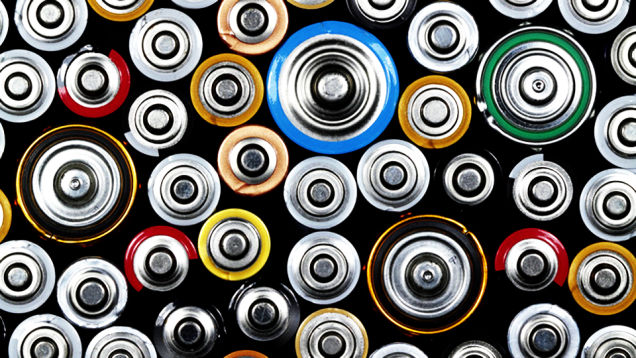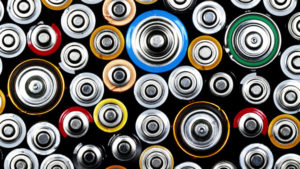Battery Types & Uses

Batteries are portable energy sources featuring three basic components – an anode, a cathode and an electrolyte. Their properties relate directly to their individual chemistries. For instance, the characteristic voltage of Nickel-Cadmium (NiCd) and Nickel-Metal Hydride (NiMH) cells is 1.2V, alkaline cells are 1.5V, and Lithium ion cells are 3.6V. Other features such as energy density/capacity, charge/discharge cycle life, peak current capability, and recharge-ability are similarly dependent on the cell chemistry.
Batteries also come in a wide variety of shapes and sizes – from wafer-thin and button-size devices, to very large industrial battery systems as big as a shipping container – but can all be considered in one of two broad categories: Primary or Secondary. Secondary batteries are sometimes called accumulator batteries, and a rechargeable.
Primary Batteries
A primary battery is designed to be used until it runs out, then disposed of or recycled. Although sometimes using the same active materials as secondary batteries, primary batteries are constructed in such a way that only one continuous or intermittent discharge can be obtained.
Primary batteries have the following properties:
- Single use. Discarded or recycled after they run out
- Very high impedance. Which yields a long shelf life and operating life, but only at low current loads
- Wide operating temperature range. Typically -40ºC to +85ºC
Primary batteries are available in many different types, including carbon-zinc, alkaline (which are also zinc-based, but take their name from their KOH-based electrolytes), silver oxide, zinc air and some lithium metal chemistries like Lithium Manganese Dioxide (LMO), commonly used in “coin cells” and “button cells”, and Lithium Thionyl Chloride (LTC), packaged in cylindrical form factors (AAA to D). Larger C and D size LTC batteries are a chemical hazard and cannot be transported by air.
Secondary Batteries
Secondary batteries can be recharged by a flow of current in the opposite direction of the current flow on discharge. During recharging, a higher state of oxidation is created at the positive electrode (anode) and a lower state at the negative electrode (cathode), returning them to somewhere close to their original charged condition.
Secondary batteries have the following properties:
- Designed to be recharged. Up to 1,000 times, depending on the usage and battery type
- Very deep discharges reduce life. Shorter, shallow discharges will usually improve cycle life
- Charge time varies from 1 – 12 hours, depending on the battery condition, depth of discharge (DoD) and other factors
Some of the limitations posed by secondary batteries are limited life, limited power capability, and low energy-efficiency and disposal concerns.
Secondary battery types include NiCd, lead-acid, NiMH, some lithium metal, and Li-ion batteries. Lead-acid and NiCd batteries are toxic, and are subject to stringent disposal regulations in many countries. The heavy metals used in their manufacture can cause serious environmental pollution if not recycled or stored. Compliance with these regulations may add significantly to the cost of these batteries..
Lead-Acid: The life of lead-acid batteries is directly related to its depth of discharge and duty cycle. Lead-acid batteries can be damaged by constant cycling to below 50% charge, which means that a typical car battery with a rated capacity of 500 watt-hours has only 250 watt-hours of usable capacity.
Nickel-Cadmium (NiCd) and Nickel-Metal Hydride (NiMH): These batteries offer much better energy density than lead-acid batteries. NiCd batteries perform best when they are regularly discharged completely and then recharged completely. If this is not done, they display a “memory effect”, which will limit their subsequent depth of discharge and usefulness. NiCd batteries can last for about 1,000 charge-discharge cycles and function well in extreme temperatures. NiMH batteries last approximately 40% longer per charge than comparable NiCd batteries, they’re lighter in weight, but have a slightly shorter cycle life (700 charge/discharge cycles). Both NiCd and NiMH batteries cost substantially more than lead-acid batteries.
Lithium ion: Lithium ion batteries (Li-ion) offer twice the energy per charge of NiMH and ~500 charge-discharge cycles. They are used in most mobile phones and notebook computers, but cannot sustain high currents at temperatures below 0°C and are relatively expensive.
Lithium polymer: Lithium polymer batteries can be made in thin, flat or shape-fitting forms. Their biggest advantage is that they don’t leak corrosive electrolyte. They provide ~500 charge-discharge cycles, but require smart chargers to monitor them closely. Lithium polymer batteries are not suitable for high-power applications, are limited to an operating temperature range of 0° – 65°, and are relatively expensive.
The Supercapacitor Difference
In contrast to batteries, supercapacitors can last virtually indefinitely if kept within their design limits, and their energy efficiency rarely falls below 90%. Their energy density is lower than batteries, but almost all of this energy is available reversibly. For example, a typical lead-acid battery has an energy density of 30 Wh/kg, of which only 15 Wh can be used without reducing battery life. To reversibly store this 15 Wh, about 21 Wh must be supplied. For supercapacitors with 9 Wh/kg of energy density, a 1.7kg module will provide the same storage capacity as a 1kg battery and only 16.5 Wh will be needed from the source.
Supercapacitors can be used to deliver frequent pulses of energy without any detrimental effects or reduced life, they can be charged very quickly and safely, and cycled many hundreds of thousands of times without significant degradation in performance.
A supercapacitor can replace a battery where the battery is being used primarily to provide power rather than energy. (See “Power vs. Energy”). The benefits of a supercapacitor as a battery replacement technology will be seen in terms of increased power capability and cycle life, reduced weight and size, and a wider operating temperature range.
A supercapacitor can also replace traditional capacitors, where the capacitors are being used primarily to provide energy rather than power. The benefits of a supercapacitor as a capacitor replacement technology will be seen in terms of increased energy storage, and reduced weight and size.


